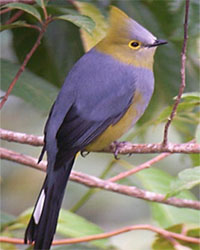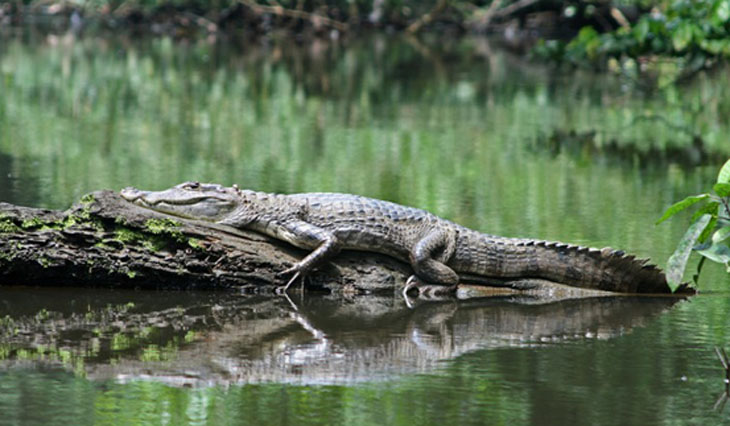|
|---|
Smiley Says: "Come On In, the Water's Fine!" |
Broken News
(All the News That's Fit to Reprint)
Ease of Doing Business Index
The Chronicles has been following Costa Rica's progress as it trudges the happy road to becoming a developed country.
One of the measurements of progress in this area is the country's ranking in the World Bank Ease-of-Doing-Business Index. We reported on this the first time in 2010 (see Rank Ranking) when Ticoland was ranked #125 out of 183 countries in the listing at that time. The latest ranking three years later puts Costa Rica at 102 in a total of 189, a gain of 29 positions. At that pace, the country is likely to end up at least in the top half (#95 or less) in a couple of years. To get to the top 20% (#38 or less) would take another 8-9 years, assuming no less than the recent rate of improvement.
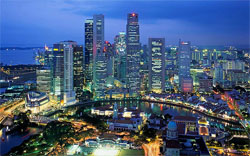 |
Singapore at Dusk |
The Index measures ease or difficulty in 10 areas of starting up, operating, transferring and closing a business. The big improvement for Costa Rica this year was credited to new online systems for obtaining business licenses and construction permits. The country rose 24 places in the starting a business category and 37 places for obtaining construction permits. The country still does poorly on protecting investors (#170), paying taxes (#136), enforcing contracts (#130) and resolving insolvencies (#124).
In overall ranking worldwide the top spots are 1) Singapore, then 2) Hong Kong, 3) New Zealand and 4) the United States. In Central America, Panama (55) and Guatemala (79) come in higher than Costa Rica. The bottom four countries in the ranking are all on the African continent: South Sudan (186), Libya (187), Central African Republic (188) and Chad (189). It's interesting trivia to note that Chad is bordered by Sudan, Libya and the Central African Republic as well as Nigeria and Cameroon. Life is tough in Central Africa.
To see this rating and other data for all countries, go here: http://www.doingbusiness.org/rankings.
Nicas Erosion Strategy
The Chronicles has also been following Nicaragua's aggressive take over of the northeast corner of Costa Rica that occurred in October 2010. Costa Rica immediately filed a complaint with the World Court, where the issue remains on the docket. In March of 2011, the court issued a ruling that both parties should withdraw from the island and take no further steps until a final ruling is issued. The ruling didn't bother the Nicas whatsoever, particularly the top dog in Managua, Danny Ortega..
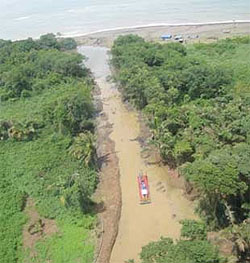 |
One of the Two Parallel Channels Dredged Through Isla Calero |
As time went on it became apparent that the Nicaraguan government had a plan for Isla Calero, the land they expropriated. The intent is to use the area to forge a new mouth for the San Juan river that is the border between the two countries. That would open up the possibility of constructing a major new canal similar to the Panama Canal and also for the development of a major new Caribbean port there.
Danny Ortega, the president of Nicaragua (apparently for life), has said publicly, while feigning interest in he World Court proceedings, that he won't abide by the court's rulings anyway. Despite the withdrawal ruling, the Nicas have routinely had government-sponsored youth camps and other groups on the island, as if it belonged to them . While the court was ruminating on the problem, the Nicas were dredging new channels through the property, two parallel ones if fact..
Nicaragua dredged the two channels with a specific purpose in mind. The San Juan is a major drainage outlet to the caribbean for giant Lake Nicaragua, and for the mountains, both in southern Nicaragua and northern Costa Rica. In the rainy season the two channels are deigned to wash away the land between them. The Nicas are depending on nature to do their initial work on opening a new river mouth while they design the canal and work out financing..
My money is still betting on this monkey business never coming to fruition as the cost estimate has risen from $30 to $40 billion and I'm guessing even Danny Ortega's leftist South American and Arab friends won't put up that kind of money for such a risky venture. More to be revealed and our crack reporting team (guess who that is) will stay on the story.
Bulletin! Dateline 22 November 2013 (OK, we did say our reporting was broken news). The World Court today issued a cease and desist order against Nicaragua on this issue and validated all of Costa Rica's claims except they kept open the question of ownership for a final ruling. The desist order requires the Nicas to fill in a portion of the newly dredged canals "within two weeks" and remove all Nicaraguan personnel from the island. We'll see amigos. Remember that Señor Ortega said during his campaign for reelection a couple of years ago that he'd ignore any ruling by the court.
Tramposa Deja Vu
Back in October of 2011, GG had one of the most emotionally difficult days of his time in Costa Rica. I learned that day that after two years of working with an intermediary to obtain my residency document, I had been scammed, taken for a ride. I had to fire the lady intermediary I was working with and start from scratch (see Gullible Travels).
 |
Gotta Get This Removed |
I was so emotionally imbalanced by events that day after firing the intermediary, I proceeded to wander to downtown San José looking for solace. So I had little defense at being sucked into yet another scam by yet another woman (see George), even on the same day. I was trying to be a good samaritan and ended up "loaning" her, my good friend, as she put it, 40,000 colones ($80) so she could get her car out of hock at a repair shop and drive back to Quepos. I was gullible and let her convince me we knew each other (she had an all-Tica mommy face).
So it was with great surprise and not a little incredulity that, on Wednesday, November 6, 2013, over two years later, who should I encounter as I walked near Hospital Mexico but my good friend once again. The tramposa ("cheat") had quickly crossed the street when she spotted me, thinking me a new sucker. As she got closer, even with one of my eyes still poor and waiting for cataract surgery, I recognized her immediately. I was wearing sunglasses for post-surgery as suggested by my ophthalmologist and that may have thrown her off.
She grabbed my arm and was about to apply her polished pitch about car troubles once more when I cut her short: " Honey, you still owe me 40k from two years ago!", I blurted. I could tell she didn't remember me - hell that was two years and quite a few suckers ago. I remonstrated with her for a few seconds more and then wished her a "Buen Dia" and walked on. I turned around a few seconds later but she had quickly melted into the crowd once again to wait for another pigeon.
A few minutes later I thought about the episode and came to the conclusion I could have handled it differently. I should have played along and then double-conned her into taking a picture with me using my cell phone. If she agreed, I could then post it on the internet and maybe drop a copy off at the local police station. Not that they'd do anything with it, but it would have given me a certain satisfaction.
You're not getting me this time, my good friend. Live and learn, Costa Rican style.
_________
Quepos now has a POPS ice cream parlor! It's located on front street right next to the Kamuk Hotel & Casino (Best Western). The Chronicles wrote an article called Galactic Treats about POPS in the September 2012 issue. The article was written chiefly because the Chronicles CEO (guess who that is) found himself unable to pass a certain POPS store near the Teatro Nacional in San José.
The new store in Quepos opened November 15. The Chronicles reporting staff (guess who that is) has been severly chastised for not being aware of this significant event until more than a week later. Good staff is hard to find these days. GG has already confirmed, a couple of times, that the Quepos product offered is the real McCoy.
Welcome (and thanks) POPS amigos.
¡Pura Vida!
All About Lightning
(Beautiful Electricity)
We have regular thunderstorms here, especially during the rainy season, and I've enjoyed watching the lightning flashes reaching across the darkened sky in the day and piercing the blackness at night.
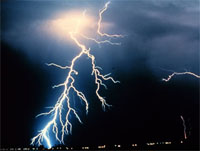 |
Koooool Stuff |
I've been fascinated by lightning since I was a boy growing up on the north shore of Massachusetts. I lived and grew up on an island (Plum Island) that was relatively flat and had a 1-3 mile wide marsh on the land side and the Atlantic Ocean on the other. This was a perfect viewing spot for thunderstorms and lightning coming from both directions.
Watching this natural phenomena can be habit forming and it became even more interesting when I lived for ten years in what is regarded as the lightning capital of the U.S., an area in Florida called "lightening alley". This is a band that cuts across the center of the state, west to east, and running from Fort Myers in the south to somewhat north of Tampa. Sarasota is in the middle of that band. This region is where warm, moist air from the Gulf of Mexico meets colder down flows from the north; the result is major thunderstorms.
Wanting to know more about lightning and how Costa Rica fits into the picture, GG issued an executive order putting the Chronicles crack research team into action (guess who that is). Here are some things that were learned:
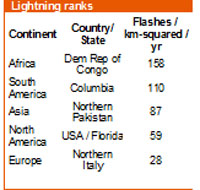 |
Lightning Capital of the World is the Village of Kifuka in the DR of Congo |
1. Lightning density mapping has improved dramatically over the last few decades due to the NASA weather satellites that now ring the earth.
2. There are approximately 1.4 billion lightning strikes in the world each year. There are 1.4 million in the U.S. alone. At any one time, there are about 2,000 thunderstorms simultaneously in progress around the globe generating some 100 flashes per second. The voltage generated can be as much as 125 million volts and reach a temperature greater than the sun.
3. While Florida's lightning alley is the leader in the U.S., the most intense lightning density in the world occurs in central Africa (see table left). The density, measured as flashes/square kilometer/year, in Africa is fully two and a half times that of North America.
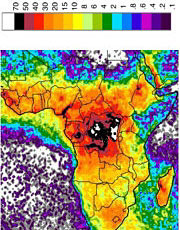 |
4. The world leader in lightning strikes is a tiny village in the east central part of the Democratic Republic of Congo (deep in the Heart of Darkness) called Kifuka. (I bet they don't even know they have that honor). In the lightning density map of Africa to the right, Kifuka is the tiny black dot inside the white patch on the right, deep in the center of the continent.
5. Only 20-30% of lightning strikes go from cloud to ground, the rest stay within the clouds. But how does lightning form? Like this, says one prof:
"Ice and supercooled water are the keys to the process, says E. Philip Krider, professor of atmospheric sciences at the University of Arizona. Violent winds buffet tiny hailstones as they form, causing them to collide. When the hailstones hit ice crystals, some negative ions transfer from one particle to another. The smaller particles lose negative ions and become positive and the larger more massive particles gain negative ions and become negative."
The smaller positive particles migrate upward with the large updrafts that occur with a thunderstorm while the larger negative particles stay lower in the atmosphere, creating a (non-psychological) bipolar potential like that which exists between the terminals of a car battery. When the potential becomes large enough, it overcomes the natural resistance of air and a discharge occurs. Zap.
It's interesting to note that, for some reason, men carry a stronger positive charge than women, which is why men get hit by lightning much more often than women (I'm not going to touch the fact that men are more positive than women and no ladies, it's not God getting back at us).
And what about Costa Rica? Well, despite the beautiful storm effects we see, Ticoland does not rank very high in lightning density. Overall, it is much lower here than the Florida average, let alone the lightning alley. What is of note is that strike density is two to three times on the Pacific Coast of Costa Rica than it is on the Caribbean Coast. I'll second that observation.
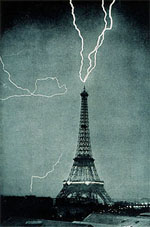 |
Now That's a Lightning Rod! |
And what to do if a lightning storm hits? Staying inside of a building is the most often encountered suggestion. One equipped with a lightning rod is even better. Staying in a car with the windows rolled up ranks second, however, you're advised not to touch the metal of the car if lightning hits it, as the metal conducts the lightning charge into the ground (the rubber tires as a source of protection is a myth).
 |
Aaron Tippin |
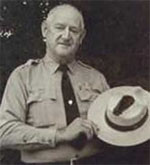 |
Roy C. Sullivan |
And lightning doesn't strike twice in the same place, right? Don't tell that to country singer Aaron Tippin. He was hit by lightning at the ripe old age of 10, then in his thirties he was hit again. Dude, stop playing an electric guitar in the rain, amigo.
But Aaron is a piker compared to a gent named Roy C. Sullivan (7 February 1912 - 28 September 1983), who was a National Park Ranger in Virginia and who holds the Guinness world record for being struck - seven (7) times. Roy committed suicide in 1983 over a relationship (striking turn of events, don't ya think).
If you are hit by lightning you may want to join a support group (there's one for everything these days). You might want to be a member of LSESSI, the Lightning Strike and Electric Shock Survivors International. There motto; "Join us if it strikes you" and their newsletter is called "Hit or Miss".
One of the things I remember about living in lightning alley was that almost all of the unplanned power outages that occurred there were related to electrical storms. Not so in Quepos, I can't remember one outage in the last five years I could attribute to lightning blowing a transformer or whatever here.
That's not to say we don't get power outages; they just seem to be for different reasons. It's not unusual to have one or two outages per month, ranging from a few seconds to a few hours) but I suspect these are related to weaknesses in the grid when power surges occur (like when too many gringo tourists turn on their computers at the same time). Another cause is a vehicle (driven by a drunk Tico or gringo tourist) taking down a power line pole in Manuel Antonio. I've noticed that our power company (ICE - Instituto Costarecense de Electricidad) is now installing much stronger power poles made out of concrete along the Manuel Antonio road (and initiating power outages regularly in order to install them. These might help in the long run.
Power is not the only outage we see here. We also get lapses in water (sometimes in the middle of a morning shower), telephone (also ICE), TV cable and Internet rather routinely. About three years ago I made a bet with a friend: if, in any week, for the entire week, all utilities work without interruption I would buy him lunch at a restaurant of his choosing in Quepos/Manuel Antonio. To date my money has been safe and my friend still goes hungry at lunch time.
I love living here; it's worth the entertainment value if nothing else.
¡Pura Vida!
Costa Rican Health Care
(A Primer - Part I, The Private System)
This is the first of a two-part series on discussing the basics of the Costa Rican health care system.
GG is often asked by visitors as well as new ex-pats, or those considering becoming an ex-pat, as to what the Costa Rican health care system is like. This two-part series will try to summarize the major aspects of Tico health care as best I understand them. Readers are encouraged to correct, embellish or otherwise add to what is being written here and I will publish their remarks (at least the pertinent and pithy ones) in future editions. To comment, reach me here: GG's Email.
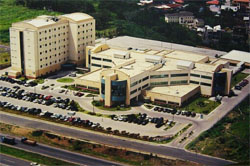 |
CIMA Hospital - San José |
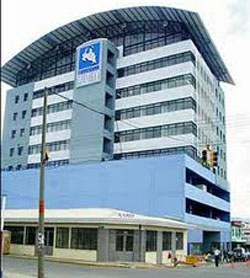 |
Hospital Clinica Biblica - San José |
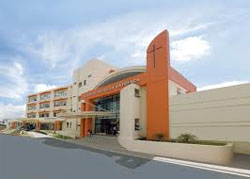 |
Hospital Catolica - San José |
Private and public health systems operate in tandem here; first, let's talk about the private system. . There are several private hospitals in Costa Rica, primarily located in the Central Valley where 60% of the population resides. The best known and most popular of the private hospitals are CIMA, Hospital Clinica Biblica and Hospital Catolica.
Hospital CIMA: The acronym stands for Centro Internacional de Medicinas; I'm not sure what the "A" stands for, probably America. CIMA is actually part of an international group of hospitals (Consorcio Internacional Hospital, S.A) and is also affiliated with the International Hospital Corporation in Dallas, TX. CIMA has it's main hospital in the western San José suburb of Escazu (an area sometimes referred to as the "Gringo Ghetto" of Costa Rica). and a second hospital in Liberia, Guanacaste province on the northern pacific coast.
CIMA has an interesting history in that it was formed less than 15 years ago primarily to treat the aged and infirm (these are my people, be good to them). It quickly grew into a full service hospital.
GG has no personal experience with CIMA but those that I've talked to who have been treated there say it's at least comparable to a first class U.S. hospital. I'm told also that a gringo is more likely to encounter English spoken at this hospital than at the others.
Hospital Clinica Biblica. Just because it says "clinic" doesn't mean that's all it is; it is in fact a full service hospital. Clinica Biblica is located in central San José (a point of trivia is that it's located a short walk from the Tracopa bus terminal where the Quepos buses terminate in case, like GG, you don't drive a car). The reports from users are that CB offers quality care and treatment, even if English is a bit less used here than at CIMA. (This is one area we ex-pats must work on; we are guests in this country and need to at least learn the basics of Spanish)
This Hospital also touts several international certifications. There are also a number of reports that costs at CB are the highest in the land and that they might demand a credit card deposit or lien (sort of like when you rent a car), before providing treatment.
Hospital Catolica. As the name implies, this is the biggest of the Catholic hospitals in the country located in Guadeloupe, in the eastern quadrant of San José. It just so happens that GG did have an experience here not long after I contracted congestive heart failure only two months after arriving here in 2008. Not able to be in the public health care system at that time, I had to rely on local private health care (more on this in next month's Chronicle).
After I had recovered from that threat due to the treatment by a good local doctor, my landlady recommended me to her cardiologist at Hospital Catolica. He was a very thorough doctor and did a battery of tests that took several hours and $300. The people were very friendly and helpful but I had to terminate the relationship when the good doctor started talking about investigating a possible blockage he wasn't sure of and that he'd like to do a $5,000 angioplasty that might lead to stints, etc. Sorry amigo, but we're not all rich gringos and I didn't have any insurance at the time. We parted ways amicably but I was definitely impressed with the quality of treatment.
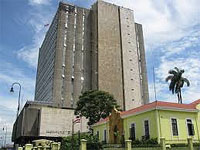 |
INS Building Next Door to Casa Amarilla (Immigration Executive Office) |
Many ex-pats prefer to use the private health care system to avoid the waiting lines in the public system (more on this next month) and they buy health insurance to support this. Until recently, all insurance policies had to be purchased through INS (Instituto Nacional de Seguros) , the government owned insurance monopoly. But, just like what is being done with the Costa Rican communications industry, the government is trying to open up the insurance market to private companies and competition. Health insurance policies of varying coverage and cost are now being offered in Costa Rica by CIGNA and other international firms.
Private health care doctors abound throughout the country. There are several in Quepos alone. However, the local doctors usually are general practitioners and, if you want or need a specialist, you may have to go to San José or where there is a larger hospital like Puntarenas or San Isidro to find what you're looking for. Many doctors here split their time between the national health care system and their own private practice. My first encounter with a doctor here was with a doc who had his private clinic 1 1/2 blocks from where I live. When I eventually joined the national healthcare system, I was fortunate enough to have this same doctor appointed as my public physician..
The cost of private medical care here, excluding drugs, can be anywhere from 40-70% of that in the U.S. Basically, this reflects the disparity of wage differences between the two countries as medical services are highly labor intensive and the average per capita income here is about one-seventh that of the U.S. This is why we have many visitors who come here to get a procedure and save money - we call it "medical tourism". You can come to go fishing and get a cataract operation while you're here. Also, I suspect, but don't know for sure, that insurance premiums here reflect the lower cost of health care.
 |
Say "Ah"; $50, Say "Wow!" |
As an example of the cost differences here versus the U.S. I offer my own experiences. In his second year here, GG disrespected some razor wire while putzing around on his balcony and came up short, right into the stuff, opening a very bloody, one inch wound on the top of his punkin head (I can see my ex-wife chuckling at that scene). A visit to the emergency room at the Quepos hospital included medicine (sedative), cleaning of the wound by a technician and 12 stitches by a doctor. Total charge $55.
In another example, I broke a front tooth a couple of years ago and went to a local dentist, fretting in my head that if it costs more than $300 to cap it, I'd content myself by walking around with the look of a bar fighter instead. The dentist offered me a choice of enamel or acrylic caps. "What's the difference?" says I. "The enamel requires a mold and some outside effort - cost $300; it will last forever. The acrylic is put in place in my office - cost $50; it will last a long time but probably not as long as the enamel". Says GG: "I won't last forever either, amigo - give me the acrylic".
After a while I was so happy with the acrylic cap I went back and had another tooth done. The second tooth was a little off angle and yellow - 30 minutes - $50. I can't tell the difference between a couple of enameled ones I had done 40 years ago and the new acrylics (except the enameled ones have yellowed a bit).
Hell at these rates I could change them out annually.
Next month the Chronicles will offer Part II, the Costa Rican Public Health System.
¡Solo Bueno!
Froggy Went a Courtin'
(Color Me Poisonous)
Costa Rica is home to more than 5,000 species of living things (this number does not include marine life or plants but does include Ticos and Gringo residents). Of this number, over 3,000 are types of insects and almost 200 are species of frogs.
Ribet! (Costa Rican Frog Sounds at Night) |
Frogs are found in almost any country but thrive in tropical and sub-tropical zones. Costa Rica is exceptionally well enriched with them and by them. Even in Quepos, which is a small city and mostly covered by paved streets, houses and stores, there is just enough greenery around, even in the center of the city, to serve as home to many kinds of frogs. Often, when I walk two blocks to the futsal (indoor football arena) at night I pass an outdoor soccer field and the frogs loudly and enthusiastically greet me, particularly after or during a rain. (To hear several types of Costa Rican frogs at night, click on the link to the right)
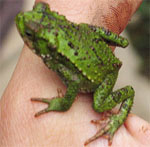 |
Common Rain frog |
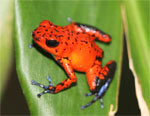 |
Strawberry Poison Dart Frog |
 |
The Glass Frog - A See-Through Frog |
 |
Gladiator Tree Frog |
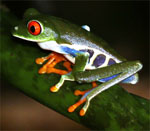 |
Red Eyed Tree Frog |
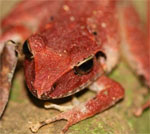 |
Red Frog (Needs a Better Name) |
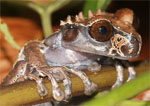 |
Spiny Headed Tree Frog |
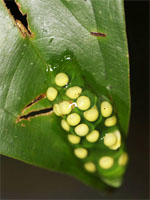 |
Frog Eggs on a Leaf |
The pictures left and right are a small sampling of our "ranas y sapos" (frogs and toads). The variety is phenomenal. Many of these frogs are quite small, the Common Rain Frog for example is only 2-3 centimeters or about 1 inch in length. The largest of the poison dart varieties rarely exceed 2 inches or 5 centimeters.
Frogs have a long list of predators including spiders, birds, mammals, lizards and especially snakes. There are many snakes that have frogs as the only item on their menu. But there is a certain kind of frog that even the snakes won't eat if they know what's good for them. These are the poison dart frogs and there are eight species of them in Costa Rica. These cute little buggers excrete a venom from pores on their backside.
In the past, natives used the venom to coat their darts and arrows, hence the name of the frog. In turn the arrows were used by the natives to fell prey such as boar, guinea pig, wild turkey and maybe an occasional monkey. The arrows impregnated with poison dart frog venom were not used in tribal conflict because the venom of a poison dart frog is not fatally toxic to a human (it could make you quite sick if ingested though).
The poison dart frogs do not have any physical mechanism to inject venom into a human; no stinger or even spikes on their backs to break the skin of a predator (some non-poisonous frogs do have a few harmless horns or spines). To foil their stalkers and discourage the hungry, they simply exude the venom onto their backs. They also are very colorful, which gives predators fair warning.
The natives achieved maximum extraction of the venom by very slowly cooking the frogs over a fire to release the juice. (That'll get the juice out of most things)
Frogs eat insects, snails, spiders, worms and even small fish. The largest of the frogs have even been known to go after mice. Since frogs have no teeth to chew their meals, they have to swallow their meals whole. Gulp, ribet!
While it looks like frogs mate physically much in the same manner as humans (use your imagination), actually the male is just helping to squeeze the eggs out of the female. Once the eggs are deposited, on a leaf for example, the male fertilizes the eggs externally (I'm not touching that one amigos). The eggs are not deposited in streams along the banks because fish will eat them. When the tadpoles hatch, mommy will carry them to a safer spot for them to grow, like a watery pool inside a bromeliad plant. Frog tadpoles might even be fed unfertilized frog eggs by their momma.
In the past, it was believed that the bright colors of some frogs were used to attract mates. Recently, however, a study at the University of Costa Rica has shown that the frog females can't distinguish a green from a red colored frog, they're sort of color blind (I've met some women like that). The mating calls are the chief thing that the females react to and different frog species are able to tune into the right calls.
GG says: Ribet! Croooaak!, Brrrrrrrrrrt!
What's-in-a-Word
Tramposa (trahm-po-sah)
Spanish word for a (feminine) cheat or fraud; the masculine would be tramposo.
Dead Ringer
Among other misguided myths of the Middle Ages was the belief that church bells actually diffuse lightning. In fact they act like lightning rods and attract it. For some time the bells were engraved with the latin: Fulguro Frango ("I break up the lightning"). Finally, some medieval scholar debunked the myth by actually studying bell ringers over 33 years during which he observed 386 lightning strikes on church bells producing 103 fatalities or "dead ringers".
ROMEO Corner
(Retired Old Men Eating Out)
Emilio's Cafe
Location: Top of Manuel Antonio hill on the road to Hotel Mariposa (20 meters west of the main MA
road to the beach) just east of the hotel on the same side of the road.
Hours: 7 AM to 9 PM, Wednesday thru Monday, Closed Tuesdays
Parking: Limited, on the side of the road.
Contact: Tel.: 2777-6807; Email: N/A; Website: N/A
Reviewing ROMEOS: Duston R., David H., Brian M., Sari H., Davis H., Tim D., Bob N.
To Review Our Rating System and Procedure, go here: R.O.M.E.O. Rating System
Emilio's had already built a good reputation as a coffee and dessert shop before moving to this new location.
The new location is considerably bigger than the old and sits nestled into the west side of Manuel Antonio hill so that the restaurant offers that classic view of the jungle dropping below until it meets the Pacific. The location also provides for much of the year, a tremendous vantage point to enjoy the sunset. Like all the restaurants in Manuel Antonio, to enjoy the sunset, you should arrive around 5 PM and take an early dinner.
The restaurant is decorated in simple Tico format, i.e., heavy wooden tables and chairs, no tablecloths, paper napkins, no flowers or other decorations on the tables. GG gives their effort one additional point for at least having a cushion on the seats to help his bad back. For atmosphere we give Emilio's 4 sloths.
The menu given us was the breakfast and lunch offering, which means that these selections must also be available any time of the day. In addition there were two different blackboards that listed about 8 specials for dinner. The seven ROMEOS attending chose a variety of the specials including three having a churrasco (grilled) strip steak, two had a fish filet with different toppings, one had a shrimp dish and another chicken curry. My fish filet was topped with a ginger based white sauce that was tasty without being overpowering. It was accompanied with plain rice and a medley of steamed vegetables, both of which complimented the fish well. I stole a piece of a dining partner's churrasco and was surprised by the flavor and tenderness of the beef; it was as good as any I've had in this country. |
 |
|---|---|
$$$1/2 |
|
Value Index = 129 |
All the ROMEOS graded their main courses as delicious and we give the restaurant five sloths for quality of food.
One of the problems with dining at Emilio's is that you can't resist seeing the desserts offered and spread out in a large case on the side of the dining room. Emilio's does good things with chocolate. Several of the group ordered a piece of chocolate mouse pie, which I sampled (yum). GG immediately spied (and later ordered) the "Tres Chocolates" dish that consisted of a graham cracker like crust with a layer of dark chocolate, then a layer of whipped white chocolate and topped with a layer of milk chocolate. I'd like to suggest we rename this dish "éxtasis de chocolate" or chocolate ecstasy. Life is good here amigos.
The service on the part of our waiter was friendly and efficient. We give Emilio's and overall rating for atmosphere, food quality and service of 4 1/2 sloths.
My bill for the fish course, chocolate ecstasy, ginger ale and a coffee, tax and obligatory service charge of 10% was just about 10,000 colones ($20). One person who had three courses came in at 12,000. That competes exceedingly well in an area like Manuel Antonio for the quality of food we got. We give Emilio's a cost rating of 3.5 sloths and a value index of 4.5/3.5x100 = 129, putting the restaurant in the top 20% of our restaurant ratings for value.
Even if you don't get a chance to try dinner there, be sure to stop for a delicious dessert and coffee. It's also a great place for breakfast, lunch or an aprés-beach snack.
About three months after this review, GG and an amigo returned to Emilio's for breakfast. The golden one had eggs benedict. It was offered with either salmon or ham; GG had the salmon. In addition to a hollandaise sauce as authentic as I've ever had in Costa Rica, the plate included home fries on a bed of watercress and a triple slice of avocado. The coffee was black, no sugar ("pura Costa Rica" I like to call it) - the best. The breakfast was outstanding!
don Beto de Quepos,
El Gringo Dorado Pura Vida! |
Be pithy but kind. I'm sensitive. |
|---|
